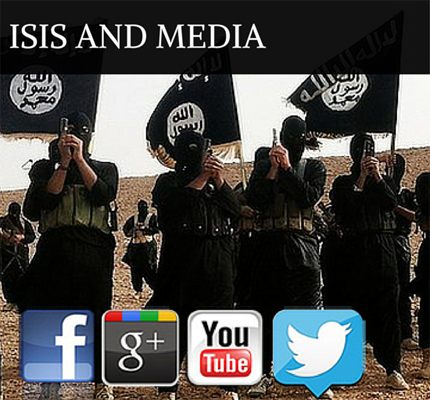ISIS and Group's Media Tactics
Introduction:
As swords and guns were the only decisive weapons of past and played a central role in battles, the media (including, mobile phones, cameras, internet, computer and TV) have become the modern tools and game-changer in war and strategy building. Today, the media has a huge influence on the masses, can convey messages and propagandas, and implant certain ideas into the minds of its viewers. It is no surprise that the terrorist networks are fully aware of the power and authority of media technology and are effectively using it to achieve their goals as well as to reach their targeted audience.
Media campaign has always been a vital tool of ISIS propaganda all over the world and the group's sophisticated and skilled media department uses well-planned strategy to target local and worldwide audience. The group has developed capability to publish their own magazines, newspapers, pamphlets and widely use internet (especially social networking websites) to propagate their ideas and goals.
The ISIS also skillfully uses media to legitimize their authority in the controlled areas, threaten its enemies while directly communicating with the people all over the world. Consequently media gives ISIS an opportunity to not only attract like-minded people globally but also frighten its opponents.
According to Deputy Commissioner of Intelligence & Counterterrorism of the NYPD, John Miller, “[the ISIS leader] Abu Bakr Al-Baghdadi has demonstrated a good understanding of military tactics but he may have the most creative marketing sense for packaging mass murder since Goebbels.”
To this day, ISIS remains active in social media apparently for several reasons: firstly, to publicize its campaign of slaughtering captives and instill fear in the hearts and minds of their opponents and rivals. Secondly, to indoctrinate their ideas into the minds of youth (especially among Muslims), as well as to recruit new militants, strengthen its force and area of influence. Thirdly, to legitimize their authority in the controlled regions with propagation of the “benefits” of living in Islamic State. Fourthly, to establish liaison with other militants, supporters or sympathizers and to persuade them to execute ISIS-style attacks in foreign lands.
Following are some of the examples of ISIS media campaigns:
Social Media
ISIS media wing use Twitter, YouTube, Facebook, Instagram, Tumblr and other social networking websites to upload its propaganda material and observe dispersal of its ideas globally in matter of minutes or hours.
Initially ISIS used social media to compete with Nusra Front (Al-Qaeda's affiliate in Syria) and social media was used as a stage for airing accusations and debate over the criteria of jihad in Syria. At that stage, ISIS’s main focus was to gain popularity in Iraq and Syria and strengthen its position in Arab world. However, after ISIS achieved its initial goals and captured important cities in Iraq and Syria, the group started to propagate its authority and show its ability to govern, by tweeting pictures of administrative services in the areas under its control.
After ISIS captured Mosul city, its messages pivoted towards the West. Although majority of the group’s posts and messages were still in Arabic but ISIS also started to post tweets in English and translated videos, which was to target Western audience. One example of it was the image of two ISIS fighters posing over a caption comparing jihad to the video game “Call of Duty”, which was aimed to attract young Westerners.
Although the images circulated in Western media were only projecting inhumane and brutal behavior by ISIS, but the local media (especially the ones under ISIS influence) portrayed both sides. ISIS media depicted piles of corpses (to threaten its enemies), and also showed its fighters passing out candy (conveying a message that, while ISIS turned the rest of the world into a graveyard, for the faithful life would be sweet).
Since Twitter, Facebook, YouTube and other related websites are open and public by nature; therefore ISIS took advantage of these platforms by using it as a propaganda tool. ISIS fighters often use social networking websites to post messages, images and videos, while the fighters on the battlefield often pose next to mutilated bodies to be seen by anyone following the fighting.
Click Here to Download Full Report 

















